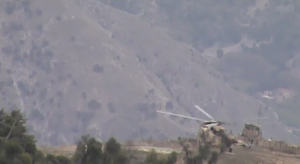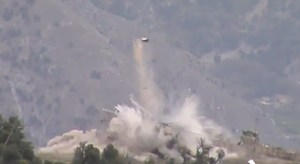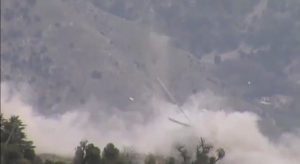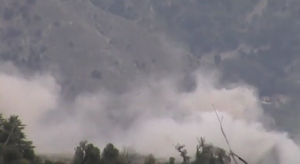The Taliban destroyed an Afghan National Army helicopter as it landed on a remote Army base in the northeastern province of Kunar late last month. The Afghan government previously claimed the helicopter was damaged in an “emergency landing,” but the Taliban recorded the attack on video.
The dramatic video was produced by Al Emera, an official propaganda outlet of the Taliban, and released today by Taliban spokesman Zabihullah Muhajid.
The Taliban claimed the helicopter, an Mi-8 Hip transport, was destroyed by an IED, or improvised explosive device, as it landed on a hilltop outpost in the Nari district in Kunar on March 24. According to the Taliban, 21 Afghan Army “commandos” were killed in the attack. The number of Afghan soldiers killed in the blast has not been confirmed.
The video is narrated by Taliban fighters who recorded the attack. As helicopter landed at the small base, several soldiers were close by watching the aircraft land. Within 30 seconds after landing, a massive blast toppled the aircraft, and completely destroyed it. There is little chance anyone onboard survived the blast. The fate of the soldiers who were watching the landing is unknown. The blast was likely caused by a bomb that was placed underneath the aircraft, as the explosion appeared to originate from under the helicopter.
The placement of the IED, which was on the helicopter landing pad inside the base, would indicate security is extremely weak on the outpost, or the Taliban placed soldiers inside who planted the bomb. Additionally, the Taliban team that recorded the video and likely detonated the bomb was close to the base, indicating that Afghan troops are not patrolling the perimeter.
The Afghan government denied initial claims that the helicopter was destroyed by the Taliban. On March 29, Kunar Governor Wahidulllah Kalimzai told Pajhwok Afghan News that the helicopter landed at the outpost due to “some technical fault.”
“The helicopter was carrying logistics for security posts and made an emergency landing on a military base after developing some technical fault,” he said, according to Pajhwok. He also claimed that the air crew was not injured in the so-called “emergency landing.”
Such reports are usually difficult to confirm as the incidents often occur in remote areas. However, both the US and Afghan militaries have a spotty track record when reporting on such incidents. For instance, on Dec. 17, 2013, a US Blackhawk helicopter went down in Zabul province, killing six US soldiers. The Taliban claimed it shot down the Blackhawk. But the US military discounted the Taliban’s claim and said in a press release that “initial reporting indicates there was no enemy activity in the area at the time of the crash.”
Three weeks later, the US military told the families of the soldiers killed that “enemy action caused the crash and loss of life.”
The exact cause of the destruction of the Blackhawk has not been disclosed, but like the Afghan National Army helicopter that was attacked in Kunar, the cause may have been an IED planted by the Taliban. Three US military officials told CNN that “the Taliban has been deemed responsible — either by shooting the helicopter or if the low-flying aircraft set off a bomb hidden on the ground.”
In the past, the Taliban has shot down several US helicopters using RPGs, or rocket-propelled grenades. The most newsworthy strike took place in August 2011 in the Tangi Valley in Wardak province. Taliban RPGs struck a US Army Chinook that was involved in a raid to capture a senior Taliban commander. That attack resulted in the deaths of 38 US and Afghan troops, including 17 Navy SEALs from SEAL Team 6, the unit that killed al Qaeda’s founder and first emir, Osama bin Laden.
Jihadists in Afghanistan have also advertised the testing of what they described as an “anti-helicopter fragmentation mine” that is designed to take out US Army Apache attack helicopters. In July 2013, the Islamic Jihad Union, the al Qaeda-linked offshoot of the Islamic Movement of Uzbekistan, displayed one such weapon in a video about its operations in Paktika province. It is unclear if such a device has been successfully deployed against US aor Afghan military helicopters.
Images from the blast that destroyed the Afghan National Army helicopter in Kunar:












3 Comments
THE DESTRUCTION OF THE AFGHAN ARMY HELICOPTER IS CONSEQUENCE OF THE GREAT MILITARY CAPACITY OF THE TALIBAN.
Aircraft Downing in Afghanistan as In Syria.
A Worthy Investigative Story In itself.
What makes things suspect…
Why Jihadi’s with Manpads is Syria.
And statements like this ” But the US military discounted the Taliban’s claim and said in a press release that “initial reporting indicates there was no enemy activity in the area at the time of the crash.”
in almost EVERY Aircraft incident in Afghanistan.
Strangely my computer collects aircraft “Incidences” in Afghanistan.
Imagine that, huh
Was it possible that the bomb was placed by tunneling under the landing pad from outside of the wire?